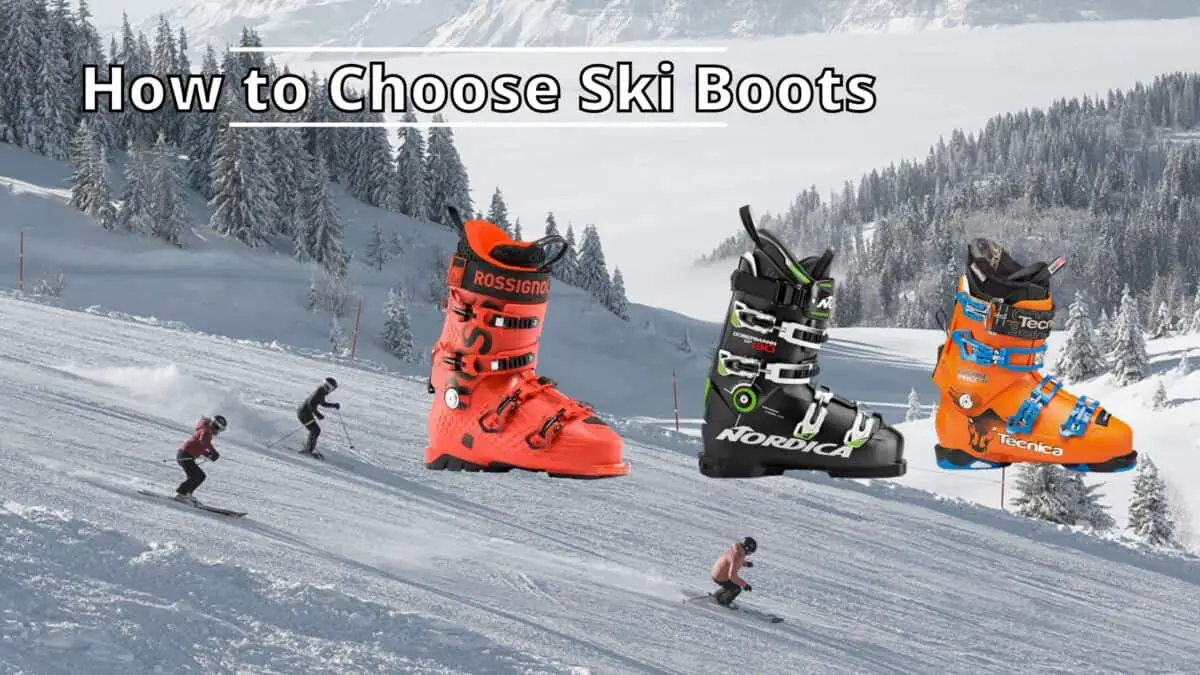Ski boots are one of the most important parts of your skiing equipment, because they are designed to transfer your movements into the skis while they support and protect your feet, ankles, and lower legs. You shouldn’t try to fit ski boots the same way as street shoes because their constructions and functions are not as comfortable.
When choosing ski boots, find the right size and shape that you will be comfortable in, and consider other factors, such as your ability level, height, and weight. Decide on the flex factor, cuff, as well as other features that will give you sufficient support and optimum comfort.
To give you further information, we’ve listed down some of the things that will help you find the right model of boots.
Choosing the right size
Mondo sizing is used for the measurement of ski boots. It uses centimeters, and corresponds exactly to the longest part of your foot. Ski boots are usually available in half sizes, and if your measurement falls in between two sizes, figure out the compression of the boot liner and choose a half-size smaller. See our sizing chart below for your reference.
Kids Size Chart:
| Mondo (Boot Size) | Kid’s US | EURO | UK |
| 15 | 8 | 25 | 7 |
| 16 | 9 | 26 | 8 |
| 17 | 10 | 27 | 9 |
| 17.5 | 11 | 28 | 10 |
| 18.5 | 12 | 29 | 11 |
| 19.5 | 13 | 30.5 | 12 |
| 20 | 13.5 | 31 | 13 |
| 20.5 | 1 | 32 | 13.5 |
| 21 | 2 | 33 | 1 |
| 21.5 | 3 | 34 | 2 |
| 22 | 4 | 35 | 3 |
| 22.5 | 4.5 | 36 | 3.5 |
| 23 | 5 | 36.5 | 4 |
| 23.5 | 5.5 | 37 | 4.5 |
| 24 | 6 | 38 | 5 |
| 24.5 | 6.5 | 38.5 | 5.5 |
| 25 | 7 | 39 | 6 |
| 25.5 | 7.5 | 40 | 6.5 |
| 26 | 8 | 40.5 | 7 |
| 26.5 | 8.5 | 41 | 7.5 |
Adult Size Chart:
| Mondo (Boot Size) | Men’s US | Women’s US | EURO | UK |
| 22 | 4 | 5 | 35 | 3 |
| 22.5 | 4.5 | 5.5 | 36 | 3.5 |
| 23 | 5 | 6 | 36.5 | 4 |
| 23.5 | 5.5 | 6.5 | 37 | 4.5 |
| 24 | 6 | 7 | 38 | 5 |
| 24.5 | 6.5 | 7.5 | 38.5 | 5.5 |
| 25 | 7 | 8 | 39 | 6 |
| 25.5 | 7.5 | 8.5 | 40 | 6.5 |
| 26 | 8 | 9 | 40.5 | 7 |
| 26.5 | 8.5 | 9.5 | 41 | 7.5 |
| 27 | 9 | 10 | 42 | 8 |
| 27.5 | 9.5 | 10.5 | 42.5 | 8.5 |
| 28 | 10 | 11 | 43 | 9 |
| 28.5 | 10.5 | 11.5 | 44 | 9.5 |
| 29 | 11 | 12 | 44.5 | 10 |
| 29.5 | 11.5 | x | 45 | 10.5 |
| 30 | 12 | x | 45.5 | 11 |
| 30.5 | 12.5 | x | 46 | 11.5 |
| 31 | 13 | x | 47 | 12 |
| 31.5 | 13.5 | x | 47.5 | 12.5 |
| 32 | 14 | x | 48 | 13 |
| 32.5 | 14.5 | x | 48.5 | 13.5 |
| 33 | 15 | x | 49 | 14 |
| 33.5 | 15.5 | x | 50 | 14.5 |
| 34 | 16 | x | 51 | 15 |
Men’s and women’s boots
Ski boots are ergonomically shaped to adapt to the differences in body shapes, such as the calves. A woman’s calf is generally lower down the leg than a man’s calf. Therefore, the cuff or the high part of the boot on women’s ski boots is lower, and flares out on the top with a specific shape at the boots’ back to suit calf shape.
A good pair of ski boots is one of the most essential pieces of equipment of your skiing kit. You need to choose a pair that provides you the best fit, warmth, and comfort to enhance your skiing experience. If you’re not sure about which pair to get, check out our best ski boots buying guide to know which shoes are perfect for you.
Flex
The flex is also an important factor to consider when choosing ski boots. It is the rigidity of your boot, and is measured on a scale from 60 to 150. Choose the ski boot’s flex based on your ability and body shape. The higher your ability level, the more rigid the boot should be, so that it will allow for more efficient power transfer from your legs to the skis. Skiers with a bigger body build will also need a stiffer flex. Although, rigidity differs between different brands, because the flex index is not an official standard.
- Beginners‘ flex index is between 60 and 90 for men, and between 60 and 70 for women.
- Intermediate‘s flex is between 90 and 110 for men, and between 70 and 90 for women.
- Advanced skiers’ flex index is 110 and above for men, and 90 and above for women.
- Expert skiers and racers choose the stiffest ski boots, with a flex index between 140 and 150.
Width
This is what’s called the ‘LAST’ of a ski boot, which is measured across the ball or the widest part of your foot. Take note of the level of precision that you need in order to choose your ski boot’s last. Choose a boot’s width that is appropriate and comfortable for you, and that will give you control over your skis. If precision is what you prefer, then choose narrower ski boots. Ski boots with too much width will not support your foot, and will not enable you to control your skis with ease.
- 3.62in (92mm): Narrow, and for racers
- 3.78-3.85in (96-98mm): Narrow footed, and for those who prefer precision over comfort.
- 3.93in (100mm): Average width, suited to most skiers.
- 3.94in (102mm): Typically for wider feet.
- 4.09in (104mm): Generally for those with very wide feet.
Tips for choosing ski boots
- Know your feet. Consider your ski boot history, and any problems that you have had with ski boots or your feet in the past.
- You can also choose to get measured by a professional to confirm the size, shape, and volume of your selected ski boot model, for it to match your feet perfectly.
- Wear appropriate socks. Most ski boots have warm padded liners to be able to support your feet and insulate them. It is best to wear thin socks, because thicker socks will make your boot tighter, and will restrict blood flow, which can result in cold feet. Thinner socks, on the other hand, will improve precision, comfort, and control.
- Make sure that you pick a pair of boots that will ensure that your feet are stable inside. It is important that you choose a comfortable footbed to really make your boots perform better.
- After purchasing your boots, wear them around the house, so that the liner will soften and mold to your feet.
- There are millions of different feet and only a small amount of brands and styles of boots. That is why ski boots are designed for modification to accommodate lumps and bumps. You can also bring your boots to a local ski shop for customization.
Ski boots that fit your feet perfectly will lead to a better experience on the slopes. If your ski boots feel a bit uncomfortable on your feet, try some of our tips on how to make your ski boots fit better to make them more comfortable to wear.
Other features to consider
Type of skiing
On groomed slopes or for on-piste skiing, choose a flexible ski boot with a flex rating below 90. Choose boots that are comfortable and easy to use, but also lightweight, and that may come with a walk mode. These ski boots suit beginners best, but also those who ski occasionally.
For on-piste skiing, racing and performance skiing, choose a more rigid ski boot with a flex rating between 90 and 130 for men, and between 70 and 110 for women. These boots allow for optimum control due to their narrower fit and high cuff.
For freeride and freetouring, choose freeride boots with a flex rating between 100 to 120, an average width of 100mm, and a straight cuff. These boots also have options to make walking easier. Look for a lightweight ski boot for climbing that will perform well in the descents. Also, choose boots with inserts that can be compatible with touring pin bindings or hybrid bindings.
Cushioning
Choose a ski boot that can protect you against impacts. A ski boots’ cushioning is typically made of foam, and some are also made with integrated gel pads.
Outsole
Opt for ski boots that can grip into icy conditions. Outsoles are usually made of a mix of foam and rubber; some integrate spikes, and more advanced materials.
Ski boots are an important investment for every skier. They are not cheap which is why it is important for you to know how to care for them to make them last longer. Lucky for you, we have a guide on how to care for ski boots which includes details about how to clean and dry them as well as how to store them properly.
Articulation
Look for a ski boot that allows some sections to flex independently to give a more fluid motion.
Power strap
For added support and response, a ski boot should have these at the top of the boot.
Heel grip
Heel grips are generally built into the ski boots’ liner, and are combined with a strategic padding or lacing to minimize the lift.
Remember that your boots form an essential connection with your skis, so they must be comfortable and provide you with adequate support.
Conclusion
Skiing is a sport that puts a lot of pressure on your feet which means that you have to pay extra attention to them in order for you to have a good skiing experience. One way of making sure that your feet are well protected and supported is by ensuring that your ski boots fit your feet perfectly.
There are many different kinds of feet but limited options when it comes to the overall build of ski boots. Finding a pair of boots that perfectly fit your feet can be very difficult, which is why we suggest that you get the best fit that you can find in the stores, then you can customize your ski boots to fit you perfectly.
Remember that your boots form an essential connection with your skis, so they must be comfortable and provide you with adequate support. While the process of getting a pair of ski boots that fit you perfectly can be quite tedious, the rewards of a better overall skiing experience will make everything worth it.

